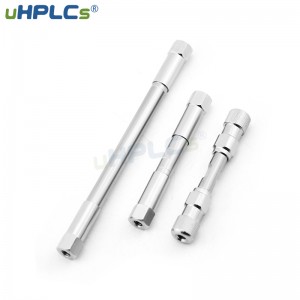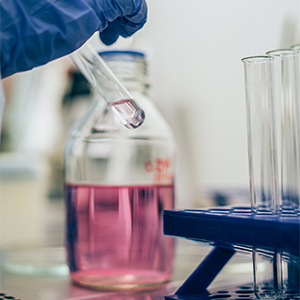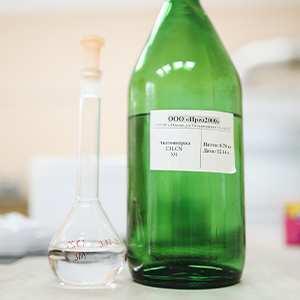Compared with gas chromatography, liquid chromatography is superior in the following aspects:
(1) Gas chromatography is not applicable to non-volatile substances and substances unstable to heat, while liquid chromatography is not limited by the volatility and thermal stability of the sample.
Some samples cannot pass through the column because they are difficult to vaporize, and thermally unstable substances decompose with heat and are unsuitable for gas chromatography. This makes the use of gas chromatography limited. According to statistics, the organic substances that can be analyzed by gas chromatography currently account for only 15% to 20% of all organic substances. On the other hand, liquid chromatography is not limited by the volatility and thermal stability of the sample. Therefore, liquid chromatography is well suited for the separation of biological and pharmaceutical-related macromolecules and ionic compounds, unstable natural products, a wide variety of other macromolecules, and dangerous compounds
(2) For samples that are difficult to separate, separation is often easier to accomplish with liquid chromatography than with gas chromatography for three main reasons.
① In liquid chromatography, since the mobile phase also affects the separation process, this provides an additional factor for the control and improvement of the separation. In contrast, the carrier gas in gas chromatography generally does not affect the partition, which means that in HPLC, two phases interact selectively with the sample molecules.
② HPLC has a broader variety of column packings (stationary phases) with unique efficacy, which allows for a more excellent choice of stationary phases, thus increasing the possibility of separation.
③ HPLC uses lower separation temperatures, and intermolecular interactions are more effective at low temperatures, so lower temperatures generally improve chromatographic separation efficiency.
(3) Compared with gas chromatography, liquid chromatography is easier for sample recovery and is quantitative, and the individual components of the sample can be easily separated.
Therefore, on many occasions, liquid chromatography is used not only as an analytical method but also as a separation means to purify and prepare single substances with intermediate purity. Although the individual sample components separated in gas chromatography can also be recovered, they could be more convenient and better quantified. Liquid chromatography is widely used in many fields because it has these advantages that gas chromatography does not have.
What are the characteristics of each gas chromatography and liquid chromatography compared to each other? Let us examine the following aspects.
I. Mobile phase
GC uses gas as the mobile phase, also called carrier gas. The commonly used carrier gases are helium, nitrogen, and hydrogen. Compared with HPLC, GC has fewer mobile phases and can be selected in a smaller range. The prominent role of the carrier gas is to bring the sample into the GC system for separation, and its influence on the separation results is minimal. In contrast, in HPLC, there are many types of mobile phases that contribute a lot to the separation results. Put another way, optimizing operating parameters in GC is more straightforward than in HPLC. In addition, the cost of GC carrier gas is lower than that of the HPLC mobile phase.
II. the stationary phase
Because there are relatively few types of carrier gases for GC, its separation selectivity is mainly changed by different stationary phases, especially in packed column GC. The stationary phase often consists of a carrier and a fixed solution coated on its surface, which has a decisive influence on the separation, so it has led to the development of a wide variety of GC stationary phases for research. Hundreds of GC stationary phases have been available to us so far. Still, there are only a dozen commonly used HPLC stationary phases. Therefore, LC depends mainly on selecting different mobile stages to change the separation selectivity. Of course, only a dozen stationary phases are commonly used in capillary GC. In fundamental analysis, GC generally selects a carrier gas and then optimizes the separation by changing the column (i.e., stationary phase) and operating parameters (column temperature and carrier gas flow rate, etc.). In contrast, LC often optimizes the separation by changing the type and composition of the mobile phase and operating parameters (column temperature and mobile phase flow rate, etc.) after selecting the HPLC column.

III. Analysis of objects
The samples that can be directly separated by GC are volatile and thermally stable, and the boiling point generally does not exceed 500℃. According to the relevant data, among the known compounds, 20%-25% can be directly analyzed by GC, and the rest can be analyzed by LC in principle. That is to say, GC has far fewer objects to analyze than LC. It should be noted that some samples that cannot be analyzed directly by GC can be analyzed indirectly by GC through special injection techniques, such as headspace injection and cleavage injection. This is the case, for example, with cracking chromatography of polymer materials. This expands the range of objects analyzed by GC to some extent. In addition, GC is more suitable for the analysis of permanent gases than LC.
IV. Detection Techniques
There are various detection techniques commonly used in GC, such as thermal conductivity detector (TCD), flame ionization detector (FID), electron capture detector (ECD), nitrogen and phosphorus detector (NPD), etc. Among them, FID responds to most organic compounds, the sensitivity is quite high, and the minimum detection limit can reach the nanogram level. In LC, there is no high-sensitivity detector with such good versatility. Commercial LC instruments are often equipped with an ultraviolet-visible absorption detector (UV-Vis) and a differential refractive index detector (RI). The former is far less versatile than the FID in GC, and the latter is less sensitive and not suitable for gradient elution. Of course, whether GC or LC, there are some selective detectors with high sensitivity, such as ECD and NPD for GC, and fluorescence and electrochemical detectors for LC. The more ideal detector should be the first MS, but at this point, GC is currently better than LC. because of the characteristics of the GC mobile phase, it is no longer any problem with the MS online coupling, especially the capillary GC and MS coupling has become a routine analytical method. In contrast, the combination of LC and MS is limited by the mobile phase. Although there are a variety of interfaces, such as ion beam, thermal spray, electrospray, etc., the choice of the mobile phase is still significantly limited.
V. Preparation and separation
In the process of research and development of new products, or in the qualitative identification of unknowns, it is often necessary to collect the components after chromatographic separation for further analysis, while certain high-purity biochemical reagents are prepared directly by chromatographic separation. In this regard, GC should be advantageous in principle because the carrier gas can be easily removed after collecting the fractions. However, since the column capacity of GC is much less than that of LC, it is quite time-consuming if GC is used for preparation. Therefore, the practical value of preparing GC is very limited. Preparation of LC, on the other hand, has a very wide range of applications.
Compare how gas chromatography differs from high-performance liquid chromatography
Difference Frist. Separation principle.
1. Gas phase: gas chromatography is a physical separation method. Using the slight differences in the distribution coefficients (solubility) of the components of the measured substances between the different two phases, when the two phases are in relative motion, these substances are repeatedly distributed between the two phases many times so that the original only a tiny difference in nature produces a significant effect, and the different components are separated.
2. Liquid phase: high-performance liquid chromatography is based on the classical chromatographic method, citing the theory of gas chromatography in terms of technology. The mobile phase is changed to high-pressure delivery (the highest delivery pressure up to 4.9´107Pa); the column is filled with small particle size packing in a particular way so that the column efficiency is much higher than that of classical liquid chromatography (the number of plates per meter can reach tens of thousands or hundreds of thousands); at the same time, the column is connected with a high-sensitivity detector, which can be continuously detected for the affluent.

Second, the scope of application.
1. Gas phase: gas chromatography has the advantages of good separation capacity, high sensitivity, fast analysis, easy operation, etc. However, subject to technical conditions, substances with too high a boiling point or poor thermal stability are challenging to apply gas chromatography for analysis. Generally, for 500 ℃ below, the non-volatile or heat-easily decomposed material part can be used derivatization method or cracking method.
2. Liquid phase: high-performance HPLC only requires the specimen can be made into a solution, without the need for gasification, and therefore not subject to the restrictions of the volatility of the example. For high boiling point, poor thermal stability, and considerable relative molecular weight (more than 400) of organic substances (these substances account for almost 75% to 80% of the total number of organic substances), in principle, can be applied to the separation and HPLC analysis. According to statistics, the known compounds can be analyzed by GC, accounting for about 20%. They can be analyzed by liquid chromatography, accounting for about 70 ~ 80%.
Third, the structure of the instrument.
1. Gas phase: consists of carrier gas source, injection part, column, column temperature chamber, detector, and data processing system. The temperature of the inlet section, column, and detector are in the control state.
1.1 Column box: The column is the heart of the gas chromatograph. The components in the sample are separated in the column after repeated distribution to achieve the purpose of analysis, and the role of the column box is to install the column. Since the two ends of the column are connected to the injector and the detector, the lower ends of the injector and detector (connectors) are inserted into the column box. The column box is capable of mounting a variety of packed and capillary columns and is easy to operate. The chromatographic column (sample) needs to work under certain temperature conditions, so the temperature of the column box is controlled by a microcomputer. The gradient in the column chamber is small due to the reasonable design. For some samples with complex composition and wide boiling range, the column can also be controlled by a third-order programmed temperature increase. The column can also be programmed to run automatically without manual intervention after the program is set, and the column can automatically open the back door to remove heat when the temperature is lowered.
1.2 Injector: The function of the injector is to feed the sample into the column. In the case of liquid samples, the injector must also vaporize them, so a microcomputer is used to control the temperature of the injector. Depending on the type of column and the injection method, five types of injectors are available:
1. filled column injector
2. capillary non-split injector attachment
3. capillary split injector attachment
4. capillary split/non-split injector
5. six-way valve gas injector
1.3 Detector: The role of the detector is to convert the chemical signal of the sample into a physical signal (electrical signal). The detector also needs to be at a certain temperature in order to work properly, so a microcomputer is used for temperature control of the detector. According to the chemical and physical properties of various samples, five detectors are available:
1. hydrogen flame ionization detector (FID)
2. thermal conductivity detector (TCD)
3. electron capture detector (ECD)
4. The separation, preparation, or identification of samples can be carried out correctly.
2. Liquid phase: High-performance liquid chromatograph mainly consists of an injection system, infusion system, separation system, detection system, and data processing system.

2.1 Injection system The injection operation is usually completed by a diaphragm injection sampler or a high-pressure injection booth, and the injection volume is constant. This is useful to improve the reproducibility of the analyzed samples.
2.2 Infusion system The system includes three parts: a high-pressure pump, a mobile phase reservoir, and a gradiometer. The general pressure of the high-pressure pump is l.47~4.4X107Pa, and the flow rate is adjustable and stable. When the high-pressure mobile phase passes through the chromatographic column, the diffusion effect of the sample in the column can be reduced, and its movement in the column can be accelerated, which is beneficial for improving the resolution, recovering the sample, and maintaining the biological activity of the sample. The mobile phase storage error and gradiometer allow the mobile phase to change with the nature of the stationary phase and the sample, including changing the polarity, ionic strength, and pH of the eluent, or changing to a competitive inhibitor or denaturant. This allows the effective separation of various substances (even if they differ by only one moiety or are isomers).
2.3 Separation system The system includes a column, connecting tubes, and a thermostat. Chromatographic column length is generally 10 ~ 50cm (need two connections, can be added between the two with a tube), the inner diameter of 2 ~ 5 mm, made of “high-quality stainless steel or thick-walled glass tube or titanium alloy and other materials, live with a diameter of 5 ~ 10μm size of the stationary phase (composed of matrix and stationary liquid). The matrix in the stationary phase is composed of high mechanical strength resin or silica gel, which are inert (such as silica gel surface silicic acid gene has been basically removed), porous (pore size up to 1000?) and large specific surface area, coupled with its surface after mechanical impregnation (the same as the preparation of stationary phase in gas chromatography), or chemically coupled with a variety of genes (such as phosphate, a quaternary amine, hydroxymethyl, phenyl, amino or alkyl groups of various lengths of carbon chains, etc.) or organic compounds of ligands. Thus, such immobilization has good selectivity over structurally different substances. For example, a glycoprotein from fibroblasts can be isolated after coupling pea agglutinin (PSA) on a porous silica surface. In addition, the stationary phase matrix particle size is small, and the column bed is extremely easy to reach a homogeneous and dense state, which is extremely easy to reduce the vortex diffusion effect. The matrix particle size is small, the micropores are shallow, and the sample has short mass transfer within the micropore region. These are beneficial to reduce the width of the spectrum and improving the resolution. According to the analysis of column efficiency theory, the smaller the matrix size, the larger the theoretical number N of the tower plate. This further justifies that a small matrix particle size will improve the resolution. Furthermore, the thermostat of high-performance liquid chromatography allows the temperature to be adjusted from room temperature to 60C, and by improving the mass transfer rate and shortening the analysis time, the efficiency of the chromatographic column can be increased.
2.4 Detection system The detectors commonly used in high-performance liquid chromatography are ultraviolet detectors, differential refractive index detectors,s and fluorescence detectors.
(1) ultraviolet detector The detector is suitable for the detection of samples with absorption properties of ultraviolet light (or visible light). Its features: wide range of use (such as proteins, nucleic acids, amino acids, nucleotides, peptides, hormones, etc. can be used); high sensitivity (lower limit of detection of 10-10g/ml); wide linear range; insensitive to changes in temperature and flow rate; can detect samples eluted by gradient solutions.
(2) spectrophotometric refractive index detector Any sample component with a different refractive index from the mobile phase can be detected using the spectrophotometric refractive index detector. For the detection of sugar compounds, this system is used. This system is versatile and simple to operate, but the sensitivity is low (the lower limit of detection is 10-7g/ml), and changes in the mobile phase can cause changes in the refractive index, so it is neither suitable for trace analysis, nor for the detection of gradient-eluted samples.
(3) Fluorescence detector Where a substance has fluorescence, under certain conditions, the fluorescence intensity of its emitted light is proportional to the concentration of the substance. Therefore, this detector is only applicable to the determination of organic compounds with fluorescence (such as polycyclic aromatic hydrocarbons, amino acids, amines, vitamins, and certain proteins), and its sensitivity is high (the lower limit of detection is 10-12 to 10-14 g/ml), and it can be used for trace analysis and the detection of gradient elution works.
2.5 Data processing system The system can collect, store, display, print, and process the test data, so that the separation, preparation, or identification of samples can be carried out correctly.
Post time: Dec-08-2022






